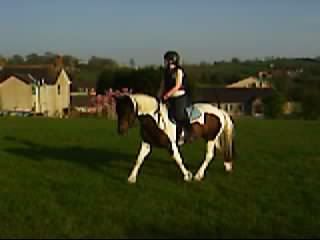|
|
Post by fleabitten on May 31, 2010 20:41:32 GMT
Right, After posting on Solomons thread, i feel i really must get some direction as to how to fix this terrible habit that i am in.
I dont ride on and never seem to be able to get them working well on the flat. I have been used to quite forward going horses at old RS and i havent really had to ride on very much in the past few years. With Kieran i have finally realised that i sort of ruined him, although it was a fixable problem. At the start he was a great wee push button pony and i could vary the pace of his canter etc and then i quit lessons and let him slop along - he got away with doing the minimum and i was just saying thats ok, instead of giving him a kick and asking him to move up a gear which made him deader and deader to the leg. So that was all my fault really.
In my lessons we would do a lot of open order work and although i made out a warm up plan i have never actually used it as i have spent the whole time trying to figure out how to get the horse working well. Now i know the methods such as transitions but have only noticed a slight change with this - i think the key though is in what im doing in between the transitions rather than the transitions themselves.
On saturday we had to canter round the school and RI said we had to change pace when she called out and we did canter, trot, canter and even walk, canter, walk. Then she asked us who had a good canter and she said i didnt have a good canter, which was true because my pony kept breaking the canter and although the downward transitions were good the upward ones were sluggish although she didnt take kicking to get moving, she was just doing the bare minimum really.
MY RI thinks i dont ride on enough because of my nerves which is partly true i think as i think also i have gotten into the habit of just sitting there in case i make the horse go faster than i intended perhaps.
Should i just concentrate on riding on for the moment and forgetting about the details like riding the corners properly and sitting up etc until i start riding on more? How can i get a horse working well?
Sorry if this is a bit rambling and long.
|
|
|
|
Post by solomon on May 31, 2010 21:10:16 GMT
I think you may be trying too hard. I hope to keep into the corners, and stay sitting nicelyetc, but not at the expense of keeping the pace. If it takes a boot to keep them going or even a tap with the whip, then do it. Tim Stockdale at your horse live summed it up well. If you do all the work then why have the horse there? Sit quietly, riding school ponies often don't allow this mind as they can be slow. Try to expect the horse to read your mind almost. Less is very often more. Hope that helps.
|
|
|
|
Post by fleabitten on May 31, 2010 21:18:26 GMT
Thanks for the reply sol  I think the problem is that i sit too quietly though lol I ask them to go and expect them to go but they dont seem to. lol I always used to slow the whizzy horses right down lol Perhaps i should ride more strongly and insist on a good pace - although i would be knackered lol I asked her to canter and she canters but not strongly so she fell back to trot a few times although i tried to anticipate this and give her a wee nudge, i did feel though i was nagging her a bit though and gripping my legs to keep her going. However, she will go because we did jumping afterwards and i rode on very determinedly and there was a definite difference in the canter when i rode her on, it was more powerful and it resulted in better rides over the jumps. This was only one pony though but i think its a problem which i need to address so i can get better and ride all types of horses effectively. She was in season which explained her unwillingness to go forward although she isnt really a whizzy pony anyway, shes very sensible. |
|
|
|
Post by scattymare on Jun 2, 2010 11:56:57 GMT
Unfortunately riding school horses do have a tendancy to become a bit dead to the leg. I would recommend you ride with a schooling whip. Ask the horse to move forward with your legs, just a squeeze. If no responce squeeze again but give a flick of the whip - it is likely that the horse will shoot forward. Do not whatever you do pull them back, but let the horse move forwards and use your seat to then collect the horse back to you. Let the horse trot on for a good few strides (at least the long side of the school) You can then ask for a downward transition and repeat the above and gradually get your transition timings shorter as (hopefully) the horse starts to respond to you. I would start this 'going large' and do not worry too much about riding into the corners to start with - again, one the horse is switched on to you and moving away from your leg you can then incorporate this. When asking for your upward transitions, make sure you are asking with a quick but firm 'in out' squeeze, not kicking, nagging or holding your leg against the side for too long (these were all habits I got into with the less than forward P!)
With your cantering it is important to try and relax intop the canter and almost feel like you're pushing the horse with your seat (my instructor tells me to imagine I'm 'scooping' her along) relax your leg and again, only use them again when you feel the horse is losing momentum - you may have to use your stick again at this point just as a little back up - but remember, don't pull them up if they shoot forwards more eagerly. You can always slip a hand under the neck strap to help you feel more secure. If you are tense or 'holding' the horse with your legs they will be unable to move forwards freely resulting in breaking pace and losing balance.
Phew sorry, bit of an essay there. I think it's hard when you are riding different horses all the time and like I said at the start, some riding school horses do become very lethargic and 'kick along' so to get the correct notes makes it that much harder for the rider.
|
|
|
|
Post by fleabitten on Jun 2, 2010 15:20:12 GMT
Thanks for that scatty  Yeah, that makes sense. I had a regular length whip and used it to back up my leg, do you think i should try a schooling whip? I have one and they probs have one or two in the whip bucket at the RS but i tried to ride Connie with it and it felt quite a handful to use and then especially trying to change it over, i guess it takes practice to be able to flick it over the top instead of through your hands. The thing that sort of baffles me is that she is responsive enough in the actual transition, it doesnt take a lot of kicking, more just that in/out squeeze you talk about but its what happens in the actual pace! I just cant seem to get the impulsion in the pace and the sharpness of the upwards transitions. |
|
|
|
Post by florence on Jun 2, 2010 19:31:05 GMT
I do understand where you're coming from about the nerves. You want the horse to go forward, but not forward into next week! Scatty has explained it very well. I would just add that you need to look upon yourself as the driver and not the passenger. As soon as you get on, take charge. You ask the horse to go forward and you choose the direction. Don't just let the horse wander - and know what you're going to do next. If the horse doesn't walk forward properly, halt and ask again, backing up with the whip if necessary. Each time you halt, make sure it's definite. Do at least three halts and make sure they're definite too - no wandering and slowing to it. This should ensure the horse is recognising and responding the halt aid and in turn make you feel more confident in controlling downwards transitions.
Have a warm up plan but concentrate on getting a good response - accuracy can come later. Tell the horse, don't ask. Remember, you don't need to go large all the time. Often it's best to do short bursts so they don't switch off or anticipate i.e. Start in walk, do three good halts walking on again straight off the leg. Trot round to other end of school, start a 20cm circle, trot the 1st half, canter 2nd half, then back to trot. Repeat other end of school, change rein. Do a three loop serpentine, canter the middle loop starting at x and coming back to trot at x. There are lots of combinations and sometimes short is sweet. Once the horse is responding better to the aid, then canter a full circle or go large pushing on if he slows.
|
|
|
|
Post by fleabitten on Jun 2, 2010 21:17:25 GMT
Yes, so basically i just need to ride on lol! I think i tend to be the passenger a lot of the time. I did out a warm up plan - yours sounds better though! I will try and do something along the lines of this and simple to remember. Thanks for your replies, if you have any more suggestions would be much appreciated  Will try this on Saturday in my lesson. |
|






 If you can't be a good example -- then you'll just have to be a horrible warning.
If you can't be a good example -- then you'll just have to be a horrible warning.